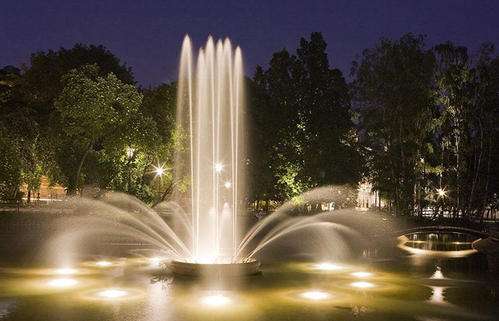Architectural aesthetic principles for the general layout of fountain water features
Publish Time:2020/02/20 NEWS 标签:fountainfountain company in Indialaser fountainNumber of views:2835
Fountain water features generally include living fountains, gushing springs, waterfalls, etc. and their matching water surfaces, so it can also be said to be a point-shaped water feature, but mainly focused on dynamic water features. The layout of dynamic point-like water features should first be compatible with the surrounding environment, that is, where should the fountain be arranged in the garden, and where should the fountain be unsuitable. This is the first issue we should consider, followed by how large the fountain is, What kind of fountain is arranged. How the various fountains are combined, and what shape the matching water surface takes. Classical fountains are mostly arranged in front of the main building or the center of the main square, forming the center of the first vision, and in terms of scale, they must be adapted to the scale of the main building or square. Formally, most of them are axisymmetric or symmetrical to the center of the circle. The most commonly used form is a large pool, mostly shaped like a garden or an oval. With the upward spraying water tongue and the drops of water splashing around, it gives a fresh, magnificent and spectacular feeling. However, the spray pattern is generally a fixed spray height and shape that does not change with time. Most are not equipped with lights, and a few are equipped with white lighting. The function of the lights is mainly to show the shape of the fountain tongue at night. Fountain company is committed to the design of music fountains ★ construction of water features enterprises, the company focuses on music fountains ★ square fountains ★ water curtain movies ★ water fountains ★ artificial fog and other technologies research and development and promotion. Fountain company professional fountain design, construction and manufacturing enterprise: a fountain company that integrates fountain design, manufacturing, installation, and subsequent maintenance. Mainly undertakes: music fountains ★ program-controlled fountains ★ dry fountains ★ community and square fountains and other fountain projects.

In recent years, due to the advancement of science and technology, automatic control, sound and light technology, and electronic technology have also been introduced into the construction of fountains. As a result, a variety of new fountains have emerged. This fountain not only has different shapes, but also its spray height, shape and Colors will change according to certain rules over time, and some are also accompanied by music, so that there are audio-controlled fountains, time-controlled fountains, program-controlled fountains, and so on. Such a fountain forms a dynamic water feature, adding a variety of elements to the original fixed buildings. And with the change of architectural style, some modern buildings have created relatively large indoor spaces, so that not only the fountains are arranged outside but also the fountains are also arranged indoors.
When we design a fountain, we must first make a general arrangement, that is, where to arrange the fountain, how large a fountain is to be arranged, and what form of the fountain is, the general arrangement is generally considered with the entire building group, and the fountain should be formed with the building. A unified and coordinated whole. Therefore, the arrangement of the fountain should also conform to the principles of architectural aesthetics, especially the basic principles of formal beauty.
(1) Neat and unified: It can also be said to be simple or uniform, which is the simplest form of beauty. This is the most commonly used rule in fountain layout. It mainly means that there are many individuals in a large fountain. At this time, we usually use the same specifications of the spray head to form the same water shape. This water shape can be a water column sprayed directly upward, or It is a water tongue that flows downwards or a water tongue that is flying upwards and a certain form of water splash. Neatness means that the same form appears repeatedly and continuously, giving a sense of regularity, giving a neat beauty, and giving a sense of order. And neatness can make relatively small individuals form a large whole, for example, a small fountain is very inconspicuous in the square, but if a row of neat small fountains will give a deep impression. A trickle fountain gives a thin feeling, but if juxtaposed in a certain shape, it will form the impression of a wall of water, a layer of water net and so on. Of course, neatness and unity cannot be absolute. It is by no means required that all fountains in the entire square are the same. Generally, neatness and unity have a certain range, that is, within a certain range, the same, beyond this range, the shape changes, and in The other area is the neatness of another body. This is called group unification. Each group has a unified form, and there are differences between groups. The grouping should be proper. If there are too many groups and too few groups, then it will go to the opposite side of the neat and unified, and it will be messy. However, the neat and unified scope should not be too large, and the grouping should not be too small, otherwise it will go to the other side and become monotonous. The principle of neatness and unification should also be reflected in that a fountain group should have a control element. The most common control element is height. For fountains, a high height main fountain is often set in a certain position, which will produce a powerful Impressions, while some smaller other fountains are in a subordinate position, giving the audience a holistic feel for this fountain group. The overall unity is also manifested in the dynamic fountain repeatedly reproducing a certain form of change in a certain cycle. This is different from the overall unity in space described above, which is the overall unity in time.
(2) Symmetrical equilibrium: Symmetry refers to a line that becomes the middle axis, and the left and right sides are equal. It can also be symmetrical relative to a center point. Compared with neatness and unification, symmetry has changed, and there have been differences in direction and position. Symmetry is the most commonly used aesthetic rule in architecture. This is because many things in nature are symmetrical, such as the positions and sizes of human eyes, ears, hands, and feet, and the shapes of various animals. Therefore, humans see more symmetry. Take things for granted. Therefore, most of the ancient Chinese buildings are symmetrical. Most of the classical fountains are also symmetrical, and most of them are symmetrical about the main axis of the building. Although some modern fountains are also seeking to break the symmetrical pattern and seek changes, most of the fountains are still symmetrical. Its basic style.
An important form of symmetric change is equilibrium. The characteristic of equilibrium is that the shapes on both sides do not have to be equal, but are roughly equal on both sides of the axis, so it is more lively and free compared to symmetry. The two sides of the layout as a fountain do not have to be the same, and the numbers do not have to be equal, but they are the same size and close in number, making people feel balanced and stable. The further change of symmetry is echo, which is more free than equilibrium. Sometimes a large fountain is arranged on one side, and several small fountains or other architectural sketches are arranged on the other side. In fact, one side is large and the other side is small. Although the shapes are very different, they take care of each other.
Although the equilibrium is not equal on both sides of the center (or axis), it has some equivalent meaning in terms of aesthetic meaning. At this point we must emphasize the center of equilibrium, otherwise we will lose the standard of measurement. It will give people a sense of disorder. So add a strong tone to the center of the balance (for example, a higher main fountain). This is the first principle of equilibrium. The second principle of equalization is the principle of leverage balance, that is, small objects that are more important away from the center can be balanced by large objects that are more important near the center.
fountain company in India has large-scale square music fountains, program-controlled fountains, sculpture fountains, laser fountain performances, water curtain movies, wave fountains, water fountains and other large-scale sculpture fountains research and development, design and production, installation and commissioning projects, and environmental landscape, square greening, etc. Integrated service case
- The structure of fountain equipment confor...
- Pay attention to safety when watching musi...
- Selection of Laser in Laser Fountain Insta...
- Fountain factory teaches you how to use su...
- Master these and make your fountain design...
- Knowledge of Waterscape Fountain in Courty...
- The fountain not only shows the taste of life
- Do you understand the key points of founta...













